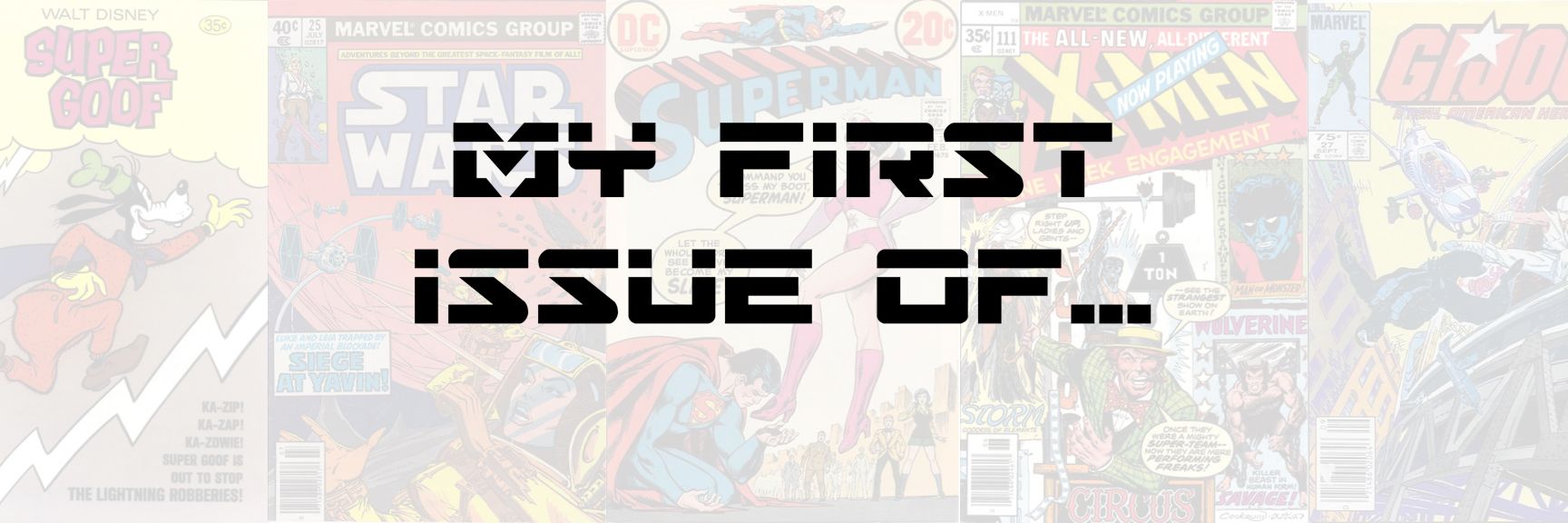
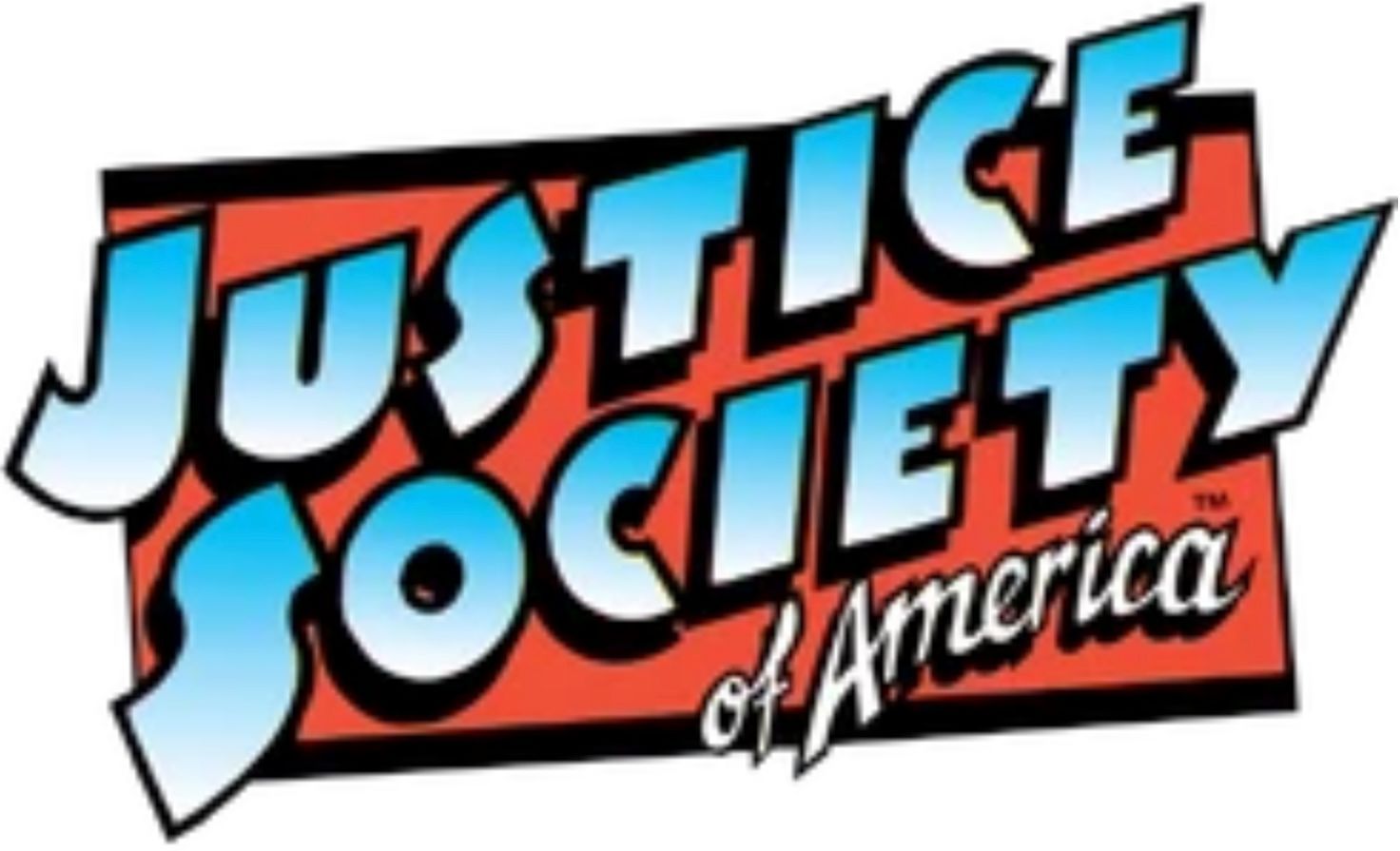
All-Star Squadron #1
cover date: September 1981
(This post was written for the podcast and blog crossover event of 2025 called JSApril. Search that term online for much more Justice Society of America greatness.)
My first encounter with the Justice Society of America was on a vacation with my parents and sibling. Despite the cover date of September, the Grand Comics Database gives an on-sale date of 26 May 1981 for the first issue of All-Star Squadron #1. It would have been June when Mom bought me this and the second issue as school was out and we were traveling from our home in Spokane, Washington to Yellowstone National Park. Back then, the only comic I actually collected was Star Wars but other comics were bought for me on special occasions. A camping trip to a National Park a couple of states away counted as such an occasion and A-SS <snicker> numbers 1 and 2 were picked up at a truck stop on the way.
What made me pick up this title that was so far outside of my normal interests? Had to be the covers! (Since I was picking up two at once, the cover for #2 also has to be given credit.) The cover to the first issue is a doozy! There are 26 heroes pictured, either in whole or in part, and 23 of them are labeled as to who they are. Of those, I only really knew six— Superman, Batman, Robin, Wonder Woman, Hawkman, and Plastic Man—and I knew them far more from cartoons than comicbooks. Another three (Flash, Green Lantern, and Green Arrow) were names I knew from Super Friends but these sure weren’t the costumes I knew!
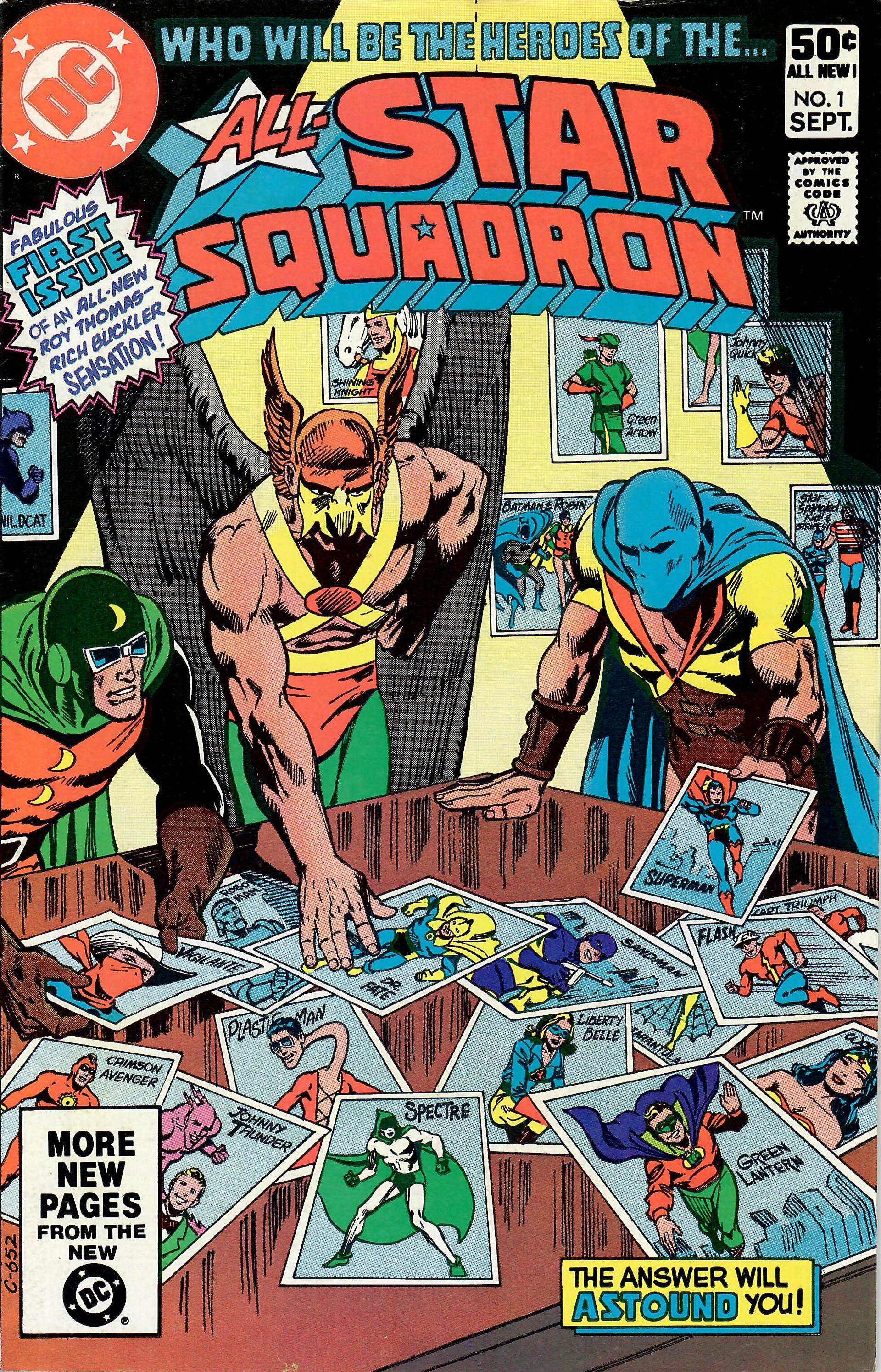
Above the snazzy, easy-to-read logo was the start of the question, “Who will be the heroes of the…” Who? Beats me! As I already wrote, I didn’t know who these people were. The art credits from GCD are Rich Buckler (pencils), Dick Giordano (inks), Tatjana Wood (colors), and Gaspar Saldino (letters). Hawman, Doctor Mid-Nite, and Housman lean over a table with scattered photos of heroes while more photos line the wall behind them. The room is dark with a light shining down on where they’re working. I particularly applaud the shadowing created in the inking stage. At the bottom of the cover, “The answer will ASTOUND you!”
Interior credits for the issue are by Roy Thomas (writer, co-creator), Rich Buckler (penciller, co-creator), Jeremiah Ordway (inker/embellisher), John Costanza (letterer), Carl Gafford (colorist), and Len Wein (editor). According to GCD, the associate editor was Mike W. Barr. The title for the debut issue? “The World Is On Fire!”
In three caption boxes on page one, Thomas educates as to the existence of Earth-1 and Earth-2 and when this story takes place on Earth-2. The splash page’s image is of Hawkman in flight and his body language tells the reader he’s in a hurry as does his thoughts. It’s a credit to the art team that so much is conveyed, not just here but throughout the issue, by the body language of the characters.
Hawkman has flown from Washington (one presumes D.C., not the state I was living in) to Manhattan this night and enters the darkened headquarters of the JSA. It’s December but someone left a window open and this has Hawkman on edge. It’s no wonder why he reacts violently when a hand grabs his leg and someone shouts, “Gotcha!” Hawkman turns out the lights to discover that his assailant is Plastic Man, a hero working for the FBI who also thought Hawkman was an intruder. Plastic Man reveals that he’s there on orders from President Roosevelt (FDR, that is).
Wesley Dodds was supposed to be watching the JSA rooms but isn’t present so Hawkman flies Plas to Dodds’s penthouse. The lights are on but no one’s home. Plastic Man switches on the radio just in time for a news bulletin that most of the Justice Society has been attacked and captured. In Los Angeles, Solomon Grundy defeated and abducted Flash, Green Lantern, and Wonder Woman. In Gotham City, Professor Zodiak flew away with Batman, Robin, and Superman his prisoners. A figure the news couldn’t identify (but I now know was Wotan) captured Dr. Fate and The Spectre near Salem, Massachusetts. Finally, Johnny Thunder, Starman, and Sandman flew up to what appeared to be a flying Spanish galleon over New York City but then disappeared with it.
Hawman tells Plastic Man that he, Dr. Mid-Nite, and The Atom were attacked at the Lincoln Memorial that night but they defeated the villain called The Monster—a villain who transformed into a smaller human form and then disappeared after glowing brightly. There only clue was the single spoken word, “Degaton.”
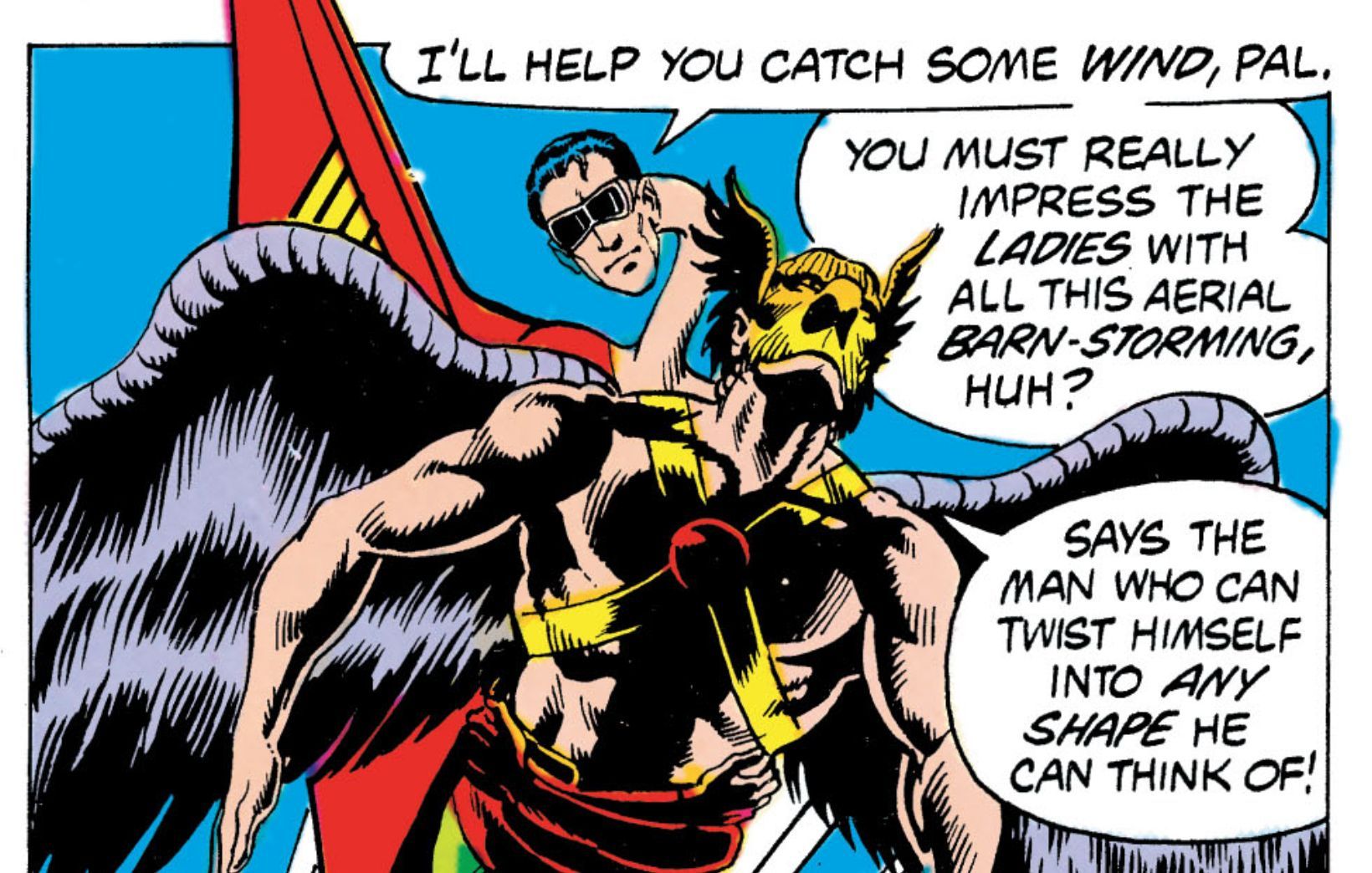
Since FDR wants to see him, Hawkman heads back towards the capital with Plastic Man on his back. They’re attacked en route by a quintet of flying men in vaguely insect-themed costumes. Plastic Man releases from Hawkman, stretches his body out, envelopes two of the drone attackers, and gently falls to Earth. The two remaining drones are no match for Hawkman’s experience at aerial combat. When he beats them, all four drones glow then disappear. This leaves their boss, the self-proclaimed King Bee. When Hawkman grabs him, King Bee declares that our hero won’t beat him again. This would be a good trick since, as far as Hawkman remembers, they’ve never met. Instead of simply vanishing, King Bee explodes with enough force to knock out the flying hero who is then caught by Plastic Man. While Plastic Man’s actions are enough to keep the fall from being fatal, both heroes are now K.O.’d and on the concrete.
An aside tells us that this has been taking place in the very early hours of 7 December 1941.
At the same time but six hours different on the clock, Shining Knight flies his horse, Winged Victory, over Hawaii. Some quick exposition brings new readers like me the basics of how this Arthurian knight came to be in the 1940s. He sees that one of the islands that shouldn’t have an active volcano is smoldering plus there’s a boat and camp on the shore. He goes to offer aid and is confronted by vulcanologist Danette Reilly. She’s there to learn about this unexpectedly active volcano even though her brother had visited in an attempt to talk her out of it. He had to leave to return to his post—at Pearl Harbor.
Danette tells Shining Knight that this island shouldn’t even be there. It only appeared a few days ago. He offers to airlift her away on Winged Victory but she insists on staying to investigate. Shining Knight decides to strike the side of the mountain with his indestructible sword. The plan may seem crazy but it does reveal a cavern. Not really a cavern, but a man-made tunnel that’s big enough for the bipeds but not Winged Victory. Danette has a lantern and they make their way inside.
Soon, they are confronted by a pair—Solomon Grundy and Professor Zodiak. Shining Knight’s armor protects him from taking too much damage but the impact still causes a concussion which knocks him out. Danette has drawn a pistol but Professor Zodiak throws something on it that melts the metal. Grundy holds back and only taps her but from someone with his strength, he knocks her across the cavern and also knocks her out.
When Shining Knight awakens, he is very thoroughly restrained. Both he and Danette—still unconscious—are glowing. The time displaced warrior thinks he sees Satan but it’s the sorcerer Wotan. Wotan doubly surprises Sir Justin by knowing his real name. Another voice states that he and all of his subordinates know who Shining Knight really is.
This is Per Degaton, the leader of this assemblage of villainy. He introduces the rest of his lieutenants: the alchemist Professor Zodiak, the brute Solomon Grundy, and Sky Pirate who is captain of the flying galleon seen earlier in the story.
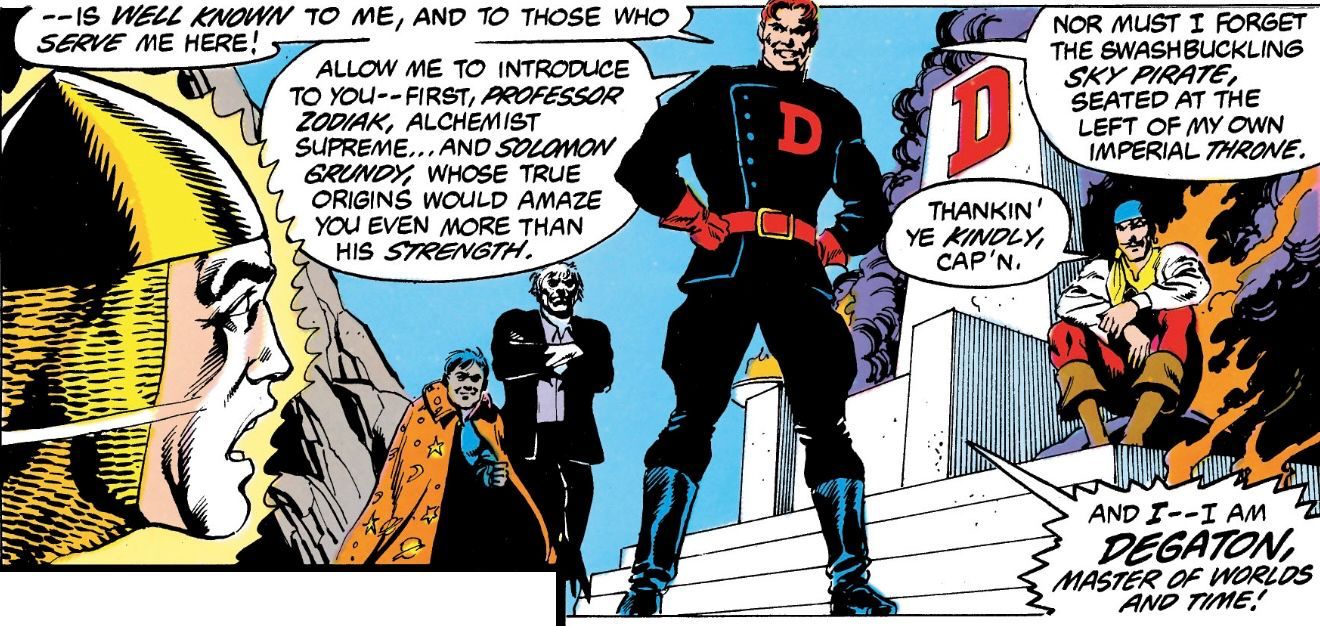
Shining Knight makes the fairly reasonable presumption that Per Degaton and the others serve the Axis powers. From the pedestal his throne is upon, Per Degaton reveals that he serves no nation or other power. He’s here to conquer the world having come from the far future of 1947! For those who lost track, that’s less than six years later depending on exactly when in 1947 is came back from.
The scene turns to Pearl Harbor and it is almost 0800. Danette’s brother, Ensign Rod Reilly of the U.S. Navy, is being driven by his friend Slugger to Wheeler Field. Wheeler Field is an Army air base. In exposition, we learn that Slugger used to be a prize fighter but gave that up to be Rod’s chauffeur in civilian life and now does the same—whether the Navy officials like it or not—in military life. We also learn that Rod has had the costumed identity of the heroic Firebrand.
As the two enter Wheeler Field in their Jeep, it is 0802 and the Japanese attack begins. Bombs fall all around the duo with one falling close enough to total their Jeep. Rod tells Slugger that they need to hurry to their ship—the U.S.S. Arizona. The men stationed at the field rush into action with pilots rushing for the remaining airplanes to engage the Japanese in the air while everyone else uses small arms to fire at the attackers.
Miles away, the U.S.S. Arizona is hit. It’s forward magazines are triggered, leading to catastrophic damage that kills over a thousand sailors in an instant.
Back at Wheeler Field, Slugger keeps up with Rod the best he can but a leg was hurt when they were thrown from their vehicle. Slugger falls and insists that Rod keep running for their ship, not knowing that it’s far too late for that. Rod turns to return to his friend and we see him gunned down by a strafing Zero. Captions tell us that the attack began at 0755 and lasted two hours.
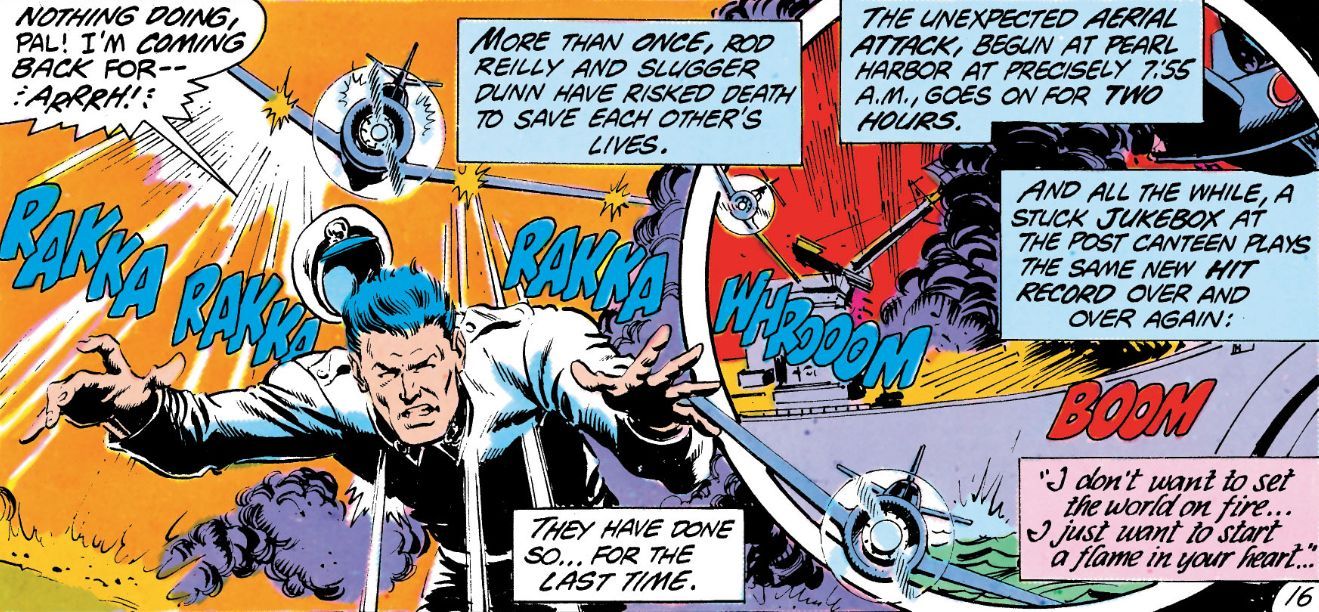
Concurrently, it is afternoon in Washington D.C. and Doctor Mid-Nite and The Atom—in costume—are at Griffith Stadium watching a football game. Well, The Atom is watching it. I guess Doctor Mid-Nite is listening. Several military officials have been summoned away over the loudspeakers and the costumed heroes decided they better find out what’s going on. In a corridor of the stadium, and FBI agent that knows Doctor Mid-Nite tells them to join him for a three-way telephone call that includes Hawaii. One the third corner of the conversation is FBI Director J. Edgar Hoover. The agent in Hawaii is reporting while the attack is still going on.
FBI agent Ed (no last name given) is to report to New York and the JSA members are to report to President Roosevelt himself. The Atom decides that the fastest way out of the building is through a locked steel door that he can’t break down. A figure in a brown suit says that he can break through the door. He tears away his suit and human-looking mask to reveal that he is Robotman. No, not the one from Doom Patrol; this is Earth-2.
Robotman easily knocks down the solid steel door. He then perches one JSAer on each of his shoulders and starts running for the White House. His metal legs propel the trio much faster than normal human ones would.
Already at the wall surrounding the White House, cameraman Johnny Chambers, accompanied by his assistant Tubby Watts, literally runs into war correspondent Libby Lawrence. Johnny suggests that they team up since they’re clearly there for the same story. Libby doesn’t want to work with anyone but tells the male duo that she can’t stop them from following her. A thought balloon from Tubby tells us that Johnny Chambers is the hero Johnny Quick. In a series of flashback panels, Johnny thinks about Libby’s tragic backstory and establishes how tough she is physically and mentally.
The news trio are stopped at the gate by a soldier and see Robotman leaping over with Doctor Mid-Nite and The Atom still on his shoulders. After the guard turns them away, Tubby is awed to see Hawkman fly into the yard carrying Plastic Man. He’s even more surprised to find that he’s now alone. Johnny Chambers has gone behind some bushes to reveal the costume of Johnny Quick and say the formula that gives him his super-speed.
Libby has ducked behind some other bushes and changes into her costumed identity, Liberty Belle. The guards—now there are two—at the gate won’t let her through but Johnny Quick picks her up at super-speed and zooms past them. The guards guess that it was The Flash. The two newer heroes join the other five at the entrance to the White House. Plastic Man vouches for them, having looked into them previously in his job as an FBI agent. Thought balloons from Johnny Quick and Liberty Belle tell us that they’ve already guessed each other’s secret identities.
The seven heroes are escorted in to see Franklin Delano Roosevelt. The President is right to the point. He tells them of the Japanese attack on Pearl Harbor and that it’s likely that American bases at Guam, Wake Island, and in the Philippines will soon be attacked. The heroes are ready to rush to the Pacific but FDR has another plan for them now that the attack on Pearl Harbor has happened. He wants all costumed heroes of America to come together into a single team, an All-Star Squadron answerable only to him. Plastic Man will serve as liaison with the FBI. The President foresees that the country will soon also be fighting the Nazis but right now wants these assembled heroes on the American west coast just in case the Japanese make it that far.
Liberty Belle asks to make a phone call. She telephones Tom Revere, stationed in Philadelphia. He rings the Liberty Bell for her. The ringing of that artifact resonates with the shard of it in her belt buckle and grants her superhuman abilities for a short time. The seven rush out of the Oval Office, ready for action.
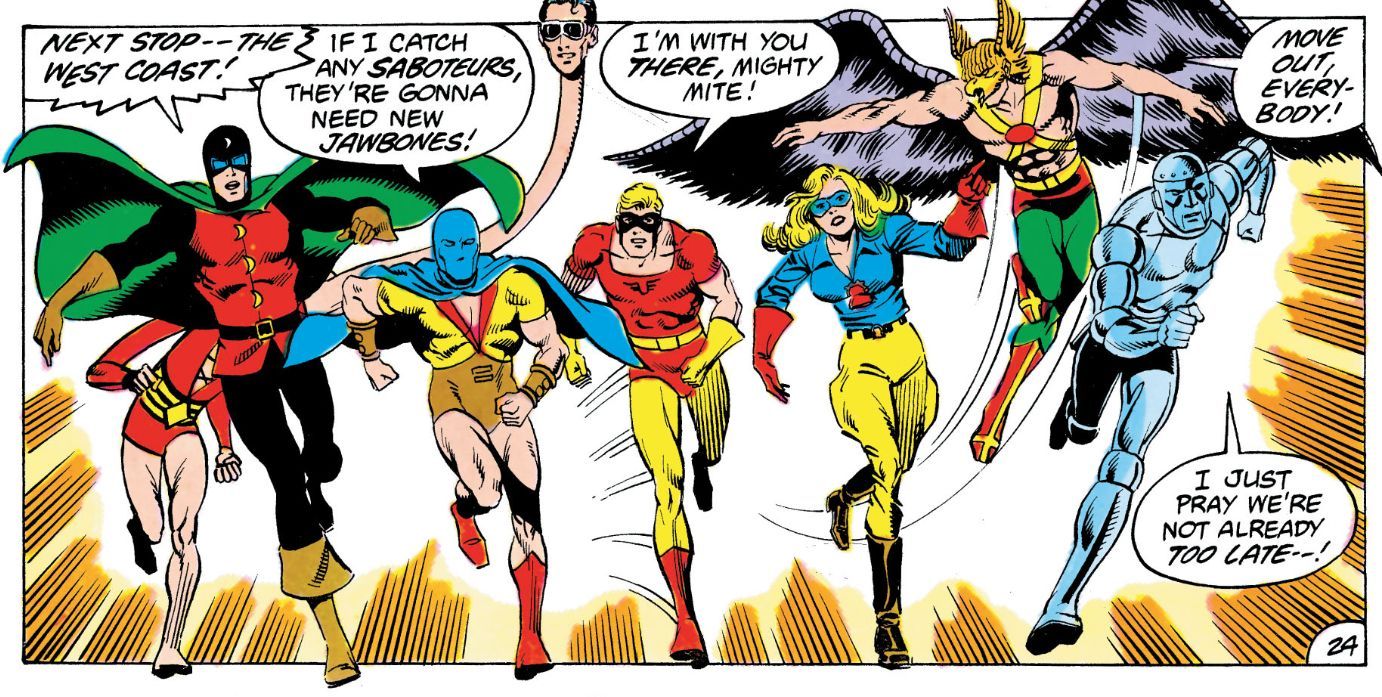
Hours later, it is night in San Fransisco. A attack is indeed forthcoming but it is a false flag attack. A submersible aircraft carrier launches a quartet of Zeroes but these pilots are under the command of Per Degaton, not the Japanese navy. The villain tells the still captive Shining Knight and Danette that his plan is to have the American mainland attacked on the same day as Pearl Harbor as part of his plan to conquer the world!
Wow! And that was just the first issue. I was able to immediately follow that up with the second issue and the third soon followed. Then—nothing. We weren’t on a trip so I was back to just my monthly Star Wars comic. I still have those first three issues but back then I’d never even heard of comic specialty stores. The only way I knew about buying back issues was garage sales and Mile High ads in the comics (which buying from was out of my ballpark).
At eight years old, the tragedy of the Pearl Harbor attack was lost on me. I was too young to really associate it with being a real thing. It was like watching a war movie on TV with my dad—just action. At age 52 (as I type this), those parts of this comic break my heart since I have a far better understanding of what happened that infamous day.
Of the few heroes that I even recognized on the cover, only Hawkman and Plastic Man have any time in this issue and this version of Plastic Man was very different from what little I remembered of his 1979 cartoon. Of the villains, the only one I knew of was Solomon Grundy, again from his cartoon appearances. Yet, I didn’t feel lost. Roy Thomas packed so much information about the heroes of this comic into the issue that I didn’t feel confused at all. Interested in learning more? Certainly! Oddly enough, I still know very little about most of the villains even after all this time.
Of the real historical figures in this story, Harry Hopkins (page 8) was America’s first Secretary of Commerce. He was a trusted foreign policy advisor to FDR and liaison to the Allied leaders in World War II. For one panel on page 18, we see J. Edgar Hoover. President Calvin Coolidge had assigned Hoover to be the director of the Bureau of Investigation, the predecessor to the FBI. When the FBI was established in 1935, Hoover was the first Director and held that position for 37 years. FDR, Franklin Delano Roosevelt, is on pages 22, 23, and 24. FDR was the 32nd President of the United States and served in that role from 1933 until his death in office during 1945.
Other real-life events woven into this story include, of course, the attack on Hawaii. I can’t find any supporting reference to the caption that claims the post canteen’s jukebox was stuck playing the song “I Don’t Want To Set the World On Fire” over and over again but multiple sources state that this song was playing on the local radio when the attack began. There was a pro football game taking place that day in Washington D.C. In the flashback of Libby Lawrence’s background, the Nazis really did bomb Warsaw, Poland then invade Holland and France. One thing that doesn’t (ahem) ring true is the Liberty Bell in Philadelphia being rung for any reason. According to the National Park Service, it was last rung in 1846!
What we now would call a meet-cute between Johnny and Libby was adorable. It would be many years later while Mark Waid was writing
Flash that I would learn the married, had a daughter, and divorced.
I cannot say enough positive things about the art team. Every page—nay, every panel—is packed with detail. Even the colors are better than average for 1981. That being said, I wouldn’t mind seeing what a modern colorist could do with a page or two of the black-and-white artwork.
This is a great comic and re-reading it after all these years was a lot of fun. Since the series is available digitally through the DC Infinite app, I’ll be reading a lot more of All-Star Squadron very soon. Oddly, the Grand Comics Database tells me it’s only been reprinted in America once in the pages of Showcase Presents: All-Star Squadron #1.
